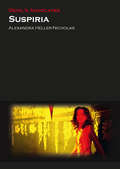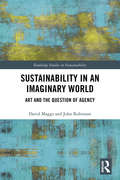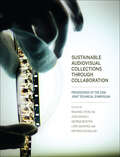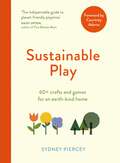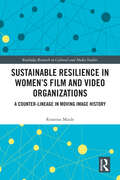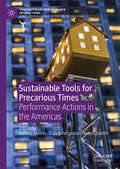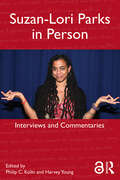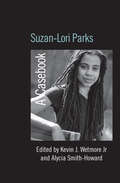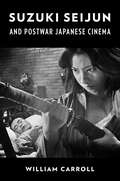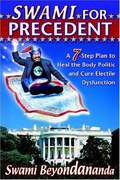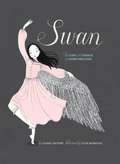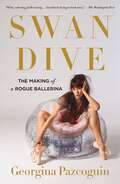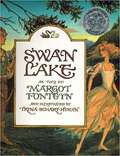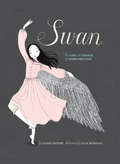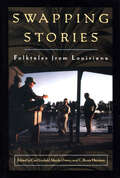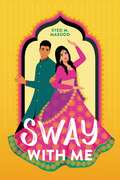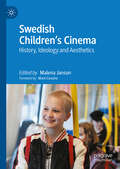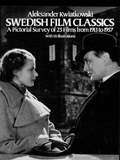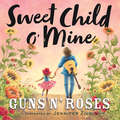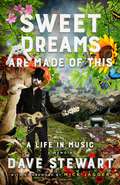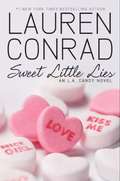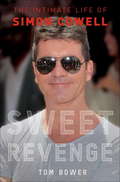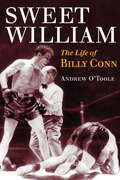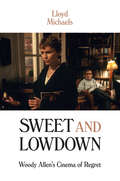- Table View
- List View
Suspiria (Devil's Advocates)
by Alexandra Heller-NicholasAs one of the most globally recognisable instances of 20th century Eurohorror, Dario Argento’s Suspiria (1976) is poetic, chaotic, and intriguing. The cult reputation of Argento’s baroque nightmare is reflected in the critical praise it continues to receive almost 40 years after its original release, and it appears regularly on lists of the greatest horror films ever. For fans and critics alike, Suspiria is as mesmerising as it is impenetrable: the impact of Argento’s notorious disinterest in matters of plot and characterisation combines with Suspiria’s aggressive stylistic hyperactivity to render it a movie that needs to be experienced through the body as much as through emotion or the intellect. For its many fans, Suspiria is synonymous with European horror more broadly, and Argento himself is by far the most famous of all the Italian horror directors. If there was any doubt of his status as one of the great horror auteurs, Argento’s international reputation was solidified well beyond the realms of cult fandom in the 1990s with retrospectives at both the American Museum of the Moving Image and the British Film Institute. This book considers the complex ways that Argento weaves together light, sound and cinema history to construct one of the most breathtaking horror movies of all time, a film as fascinating as it is ultimately unfathomable.
Sustainability in an Imaginary World: Art and the Question of Agency (Routledge Studies in Sustainability)
by John Robinson David MaggsSustainability in an Imaginary World explores the social agency of art and its connection to complex issues of sustainability. Over the past decade, interest in art’s agency has ballooned as an increasing number of fields turn to the arts with ever-expanding expectations. Yet just as art is being heralded as a magic bullet of social change, research is beginning to throw cautionary light on such enthusiasm, challenging the linear, prescriptive, instrumental expectations such transdisciplinary interactions often imply. In this, art finds itself at a treacherous crossroads, unable to turn a deaf ear to calls for help from an increasing number of ostensibly non-aesthetic fields, yet in answering such prescriptive urgencies, jeopardizing the very power for which its help was sought in the first place. This book goes in search of a way forward, proposing a theory of art aiming to preserve the integrity of arts practices within transdisciplinary mandates. This approach is then explored through a series of case studies developed in collaboration with some of Canada’s most prominent artists, including internationally renowned nature poet Don McKay; Italian composer and Head of Vancouver New Music, Giorgio Magnanesi; the renowned Electric Company Theatre, led by Kevin Kerr; and finally through a largescale multimedia installation aiming to reimagine the relationship between climate, culture, and human agency. Sustainability in an Imaginary World will be of great interest to students and scholars of arts-based research fields, sustainability studies, and environmental humanities.
Sustainable Audiovisual Collections Through Collaboration: Proceedings of the 2016 Joint Technical Symposium
by Rachael Stoeltje Vicki Shively George Boston Lars Gaustad Dietrich SchüllerThe art and science of audiovisual preservation and access has evolved at breakneck speed in the digital age. The Joint Technical Symposium (JTS) is organized by the Coordinating Council of Audiovisual Archives Associations and brings experts from around the world to learn of technologies and developments in the technical issues affecting the long-term survival and accessibility of audiovisual collections. This collection of essays is derived from presentations made at the 2016 JTS held in Singapore and presents an overview of the latest audiovisual preservation methods and techniques, archival best practices in media storage, as well as analog-to-digital conversion challenges and their solutions.
Sustainable Play: 60+ cardboard crafts and games for an earth-kind home
by Sydney Piercey'I adore Sydney's approach to play... good for our planet, and good for our souls too.' - Daisy Upton, author of Five Minute Mum'For some serious playtime inspiration follow Sydney Piercey. She does it with zero fuss or show off. She is just brilliant'. -Clover StroudParenting blogger and mother-of-three, Sydney Piercey, gained traction online with her environmentally friendly DIY toys made entirely out of cardboard.Filled with 60+ creative, accessible and plastic-free projects and play ideas, Sustainable Play is packed with crafts and games to enjoy with your children on slow, rainy or drawbridge days at home. Sydney provides you with budget-friendly, easy-to-follow ideas to play and create in this handbook, inspired by her family's love of the simple things. From step-by-step projects to create magical toys from your leftover cereal boxes to joy-filled games using everyday objects from around your home, Sustainable Play will equip you with the inspiration you need to entertain your children in a creative, stimulating and sustainable way - being kind to the planet in the process.
Sustainable Play: 60+ cardboard crafts and games for an earth-kind home
by Sydney Piercey'I adore Sydney's approach to play... good for our planet, and good for our souls too.' - Daisy Upton, author of Five Minute Mum'For some serious playtime inspiration follow Sydney Piercey. She does it with zero fuss or show off. She is just brilliant'. - Clover StroudParenting blogger and mother-of-three, Sydney Piercey, gained traction online with her environmentally friendly DIY toys made entirely out of cardboard.Filled with 60+ creative, accessible and plastic-free projects and play ideas, Sustainable Play is packed with crafts and games to enjoy with your children on slow, rainy or drawbridge days at home. Sydney provides you with budget-friendly, easy-to-follow ideas to play and create in this handbook, inspired by her family's love of the simple things. From step-by-step projects to create magical toys from your leftover cereal boxes to joy-filled games using everyday objects from around your home, Sustainable Play will equip you with the inspiration you need to entertain your children in a creative, stimulating and sustainable way - being kind to the planet in the process.
Sustainable Resilience in Women's Film and Video Organizations: A Counter-Lineage in Moving Image History (Routledge Research in Cultural and Media Studies)
by Rosanna MauleThis book illustrates a distinctive lineage of critical interventions in moving image culture and in the public sphere through the trajectories of a small number of film and video organizations established between the 1970s and the early 1980s in Western Europe and North America mainly by women and still operative today. The six case studies examined (Drac Màgic, Women Make Movies, Groupe Intervention Vidéo, Leeds Animation Workshop, bildwechsel, Centre Audiovisuel Simone de Beauvoir) have maintained a discrete yet continuing presence within an audiovisual industry and a cultural system dominated by institutionalized, state-funded, and corporate forms of audiovisual production and distribution. Their longevity—quite a rarity in the independent circuit—makes a strong case for the sustainability of feminist/LGBTQ media activism in the public sphere, in spite of its low-key profile. This volume will be of interest to academicians of history and communication studies, feminist and LGBTQ topics and gender-related cinematic culture.
Sustainable Tools for Precarious Times: Performance Actions in the Americas (Contemporary Performance InterActions)
by Claudette Lauzon Natalie Alvarez Keren ZaiontzThis book charts the changing frontiers of activism in the Americas. Travelling Canada, the US, the US-Mexico border, Chile, Argentina, Brazil, Cuba, Colombia, and Indigenous territories on Turtle Island, it invites readers to identify networks, clusters, and continuities of art-activist tactics designed to exceed the event horizon of the performance protest. Essays feature Indigenous artists engaging in land-based activism and decolonial cyberactivism, grass-roots movements imagining possible futures through cross-sector alliance building, art-activists forwarding tactics of reinvention, and student groups in the throes of theatrical assembly. Artist pages, interspersed throughout the collection, serve as animated, first-person perspectives of those working on the front lines of interventionist art. Taken together, the contributions offer a vibrant picture of emergent tactics and strategies over the past decade that allow art-activists to sustain the energy and press of political resistance in the face of a whole host of rights emergencies across the Americas.Project Artists: - The Great Collective Cough-In – L.M. Bogad - Le Temps d’une Soupe – ATSA - For Freedoms – Hank Willis Thomas and Eric Gottesman - Down with Self-Management! Re-Booting Ourselves as Feminist Servers – subRosa - Journey for Activism and Sustainability Escola de Ativismo - Unstoppable – micha cárdenas, Patrisse Cullors, Chris Head and Edxie Betts - Listen to Black Women – Syrus Marcus Ware - Notes on Sustainable Tools – Fred Moten and Stefano Harney, with Suné Woods - The Mirror Shield Project – Cannupa Hanska Luger - The Human Billboard Project – Leah Decter, with Stop Violence Against Aboriginal Women Action Group
Suzan-Lori Parks in Person: Interviews and Commentaries
by Philip C. Kolin Harvey YoungThis collection of interviews offers unprecedented insight into the plays and creative works of Suzan-Lori Parks, as well as being an important commentary on contemporary theater and playwriting, from jazz and opera to politics and cultural memory. Suzan-Lori Parks in Person contains 18 interviews, some previously untranscribed or specially undertaken for this book, plus commentaries on her work by major directors and critics, including Liz Diamond, Richard Foreman, Bonnie Metzgar and Beth Schachter. These contributions combine to honor the first African American woman to receive the Pulitzer Prize in drama, and explore her ideas about theater, history, race, and gender. Material from a wide range of sources chronologically charts Parks’s career from the 1990s to the present. This is a major collection with immediate relevance to students of American/African-American theater, literature and culture. Parks’s engaging voice is brought to the fore, making the book essential for undergraduates as well as scholars.
Suzan-Lori Parks: A Casebook (Casebooks on Modern Dramatists)
by Kevin J. Wetmore Jr Alycia Smith-HowardSuzan-Lori Parks confirmed herself as one of the most exciting and successful playwrights of her generation when her work Topdog/Underdog was awarded the 2002 Pulitzer Prize, making her the only African American woman to win the award. Despite the cultural weight of this achievement, Parks remains difficult both to pigeonhole and to summarize. This volume seeks to provide a context for her work, with essays from major and emerging scholars addressing the importance of factors such as gender, ethnicity, language and history in plays from her first major work, Imperceptible Mutabilities of the Third Kingdom to the 365 Days / 365 Plays project. Suzan-Lori Parks: A Casebook represents the first major study of this unique voice in contemporary drama. Contributors: Leonard Berkman, Jason Bush, Shawn Marie-Garrett, Andrea Goto, Heidi Holder, Barbara Ozieblo, Kevin J. Wetmore Jr and Harvey Young. Kevin J. Wetmore Jr is Professor of Theatre at Loyola Marymount University, as well as being a professional actor and director of the Comparative Drama Conference. He is the author of The Athenian Sun in an African Sky and Black Dionysus: Greek Tragedy and African American Theatre. Alycia Smith-Howard an Assistant Professor at New York University in the Gallatin School of Individualized Study, where she is the Artistic Director of the Gallatin Arts Festival and the Book Reviews Editor at the New England Theatre Journal. A Fellow of the Folger Shakespeare Library, her areas of specialization include Shakespeare, performance history, feminist theatre aesthetics and literature and drama of the south.
Suzuki Seijun and Postwar Japanese Cinema
by William CarrollIn 1968, Suzuki Seijun—a low-budget genre filmmaker known for movies including Branded to Kill, Tokyo Drifter, and Youth of the Beast—was unceremoniously fired by Nikkatsu Studios. Soon to be known as the “Suzuki Seijun Incident,” his dismissal became a cause for leftist student protestors and a burgeoning group of cinephiles to rally around. His films rapidly emerged as central to debates over politics and aesthetics in Japanese cinema.William Carroll offers a new account of Suzuki’s career that highlights the intersections of film theory, film production, cinephile culture, and politics in 1960s Japan. Carroll places Suzuki’s work between two factions that claimed him as one of their own after 1968: the New Left and its politicized theoretical practice on one hand, and the apparently apolitical cinephiles and their formalist criticism on the other. He considers how both of these strands of film theory shed light on the distinctive qualities of Suzuki’s films, and he explores how both Suzuki’s works and unheralded Japanese film theorists offer new ways of understanding world cinema.This book presents both a major reinterpretation of Suzuki’s work—which influenced directors such as John Woo, Jim Jarmusch, and Quentin Tarantino—and a new lens on postwar Japanese film culture and industry. Suzuki Seijun and Postwar Japanese Cinema also includes a complete production history of Suzuki’s filmography along with never-before-discussed information about his unfinished film projects.
Swami for Precedent: A 7 Step Plan to Heal the Body Politic and Cure Electile Dysfunction
by Swami BeyondanandaApparently, the world is in such serious condition that the Earth's protective laugh force has been compromised. Scientists have discovered a hole in the Bozone Layer -- our planetary clown chakra -- because not enough levity is rising. Boy, talk about irony. You would think that with all this serious foolishness, more people would be laughing. But sometimes being foolish just isn't funny, and we have to face the serious nature of our foolishness. And what foolishness it is! We have smart bombs, which is great. Now all we have to do is make sure our leaders are at least as smart as our bombs. And a smart leader? A smart leader knows when using even the smartest bomb is stupid.
Swan
by Laurel Snyder Julie MorstadThe world is big.Anna is small.The snow is everywhere and all around.But one night . . .One night, her mother takes her to the ballet, and everything is changed. Anna finds a beauty inside herself that she cannot contain.So begins the journey of a girl who will one day grow up to be the most famous prima ballerina of all time, inspiring legions of dancers after her: the brave, the generous, the transcendently gifted Anna Pavlova. Beautiful, inspirational, and triumphant, Anna Pavlova's life is masterfully captured in this exquisite picture book.
Swan Dive: The Making of a Rogue Ballerina
by Georgina Pazcoguin"Don't expect just tulle and toe shoes. In this fascinating insider's tale, NYCB dancer Pazcoguin reveals her world. . . . A striking debut." —PeopleAward-winning New York City Ballet soloist Georgina Pazcoguin, aka the Rogue Ballerina, gives readers a backstage tour of the real world of elite ballet—the gritty, hilarious, sometimes shocking truth you don’t see from the orchestra circle.In this love letter to the art of dance and the sport that has been her livelihood, NYCB’s first Asian American female soloist Georgina Pazcoguin lays bare her unfiltered story of leaving small-town Pennsylvania for New York City and training amid the unique demands of being a hybrid professional athlete/artist, all before finishing high school. She pitches us into the fascinating, whirling shoes of dancers in one of the most revered ballet companies in the world with an unapologetic sense of humor about the cutthroat, survival-of-the-fittest mentality at NYCB. Some swan dives are literal: even in the ballet, there are plenty of face-plants, backstage fights, late-night parties, and raucous company bonding sessions.Rocked by scandal in the wake of the #MeToo movement, NYCB sits at an inflection point, inching toward progress in a strictly traditional culture, and Pazcoguin doesn’t shy away from ballet’s dark side. She continues to be one of the few dancers openly speaking up against the sexual harassment, mental abuse, and racism that in the past went unrecognized or was tacitly accepted as par for the course—all of which she has painfully experienced firsthand.Tying together Pazcoguin’s fight for equality in the ballet with her infectious and deeply moving passion for her craft, Swan Dive is a page-turning, one-of-a-kind account that guarantees you'll never view a ballerina or a ballet the same way again.
Swan Lake
by Margot Fonteyn Trina HymanA prince's love for a swan queen overcomes an evil sorcerer's spell in this fairy tale adaptation of the classic ballet.
Swan: The Life and Dance of Anna Pavlova
by Laurel SnyderThe world is big.Anna is small.The snow is everywhere and all around.But one night . . .One night, her mother takes her to the ballet, and everything is changed. Anna finds a beauty inside herself that she cannot contain.So begins the journey of a girl who will one day grow up to be the most famous prima ballerina of all time, inspiring legions of dancers after her: the brave, the generous, the transcendently gifted Anna Pavlova. Beautiful, inspirational, and triumphant, Anna Pavlova's life is masterfully captured in this exquisite picture book.
Swapping Stories: Folktales from Louisiana
by Carl Lindahl Maida Owens C. Renée HarvisonHere are more than two hundred oral tales from some of Louisiana's finest storytellers. In this comprehensive volume of great range are transcriptions of narratives in many genres, from diverse voices, and from all regions of the state.Told in settings ranging from the front porch to the festival stage, these tales proclaim the great vitality and variety of Louisiana's oral narrative traditions. Given special focus are Harold Talbert, Lonnie Gray, Bel Abbey, Ben Guiné, and Enola Matthews—whose wealth of imagination, memory, and artistry demonstrates the depth as well as the breadth of the storyteller's craft. For tales told in Cajun and Creole French, Koasati, and Spanish, the editors have supplied both the original language and English translation. To the volume Maida Owens has contributed an overview of Louisiana's folk culture and a survey of folklife studies of various regions of the state. Car Lindahl's introduction and notes discuss the various genres and styles of storytelling common in Louisiana and link them with the worldwide are of the folktale.
Sway with Me
by Syed M. MasoodShe&’s All That goes desi in this hilarious, affecting, and sweetly romantic comedy by the author of More Than Just a Pretty Face.Arsalan has learned everything he knows from Nana, his 100-year-old great-grandfather. This includes the fact that when Nana dies, Arsalan will be completely alone in the world, except for his estranged and abusive father. So he turns to Beenish, the step-daughter of a prominent matchmaker, to find him a future life partner. Beenish&’s request in return? That Arsalan help her ruin her older sister&’s wedding with a spectacular dance she&’s been forbidden to perform.Despite knowing as little about dancing as he does about girls, Arsalan wades into Beenish&’s chaotic world to discover friends and family he never expected. And though Arsalan&’s old-school manners and Beenish&’s take-no-prisoners attitude clash every minute, they find themselves getting closer and closer—literally. All that&’s left to realize is that the thing they both really want is each other, if only they can get in step.At turns laugh-out-loud funny, poignant, and sincerely heartfelt, Sway With Me is a coming-of-age story for anyone trying to find their place in the world.
Swedish Children’s Cinema: History, Ideology and Aesthetics
by Malena JansonSwedish children’s cinema has a long and rich history. It encompasses the rascal films of the 1920s, the realism of the 1940s, the ambitious artistic renewal of the 1970s, the child empowering films of the 1990s through the early 2000s, and the multiple, exceedingly popular, Astrid Lindgren adaptations across the decades. Devoted to exploring this cinematographic legacy, this book offers close readings across academic disciplines, probing various genres, eras, media debates, transmediations, and audience-receptions. Childhood studies, with its critical comprehension of society’s changing notions of childhood, here serves as a key framework in fruitful combination with, inter alia, feminist, queer, intermedial, postcolonial, and eco-critical perspectives. This collection fills an important knowledge gap on Swedish film history as well as the distinctly Nordic tradition of children’s culture, and thereby contributes to the burgeoning field of international children’s cinema research. It is introduced with a foreword by Mark Cousins.
Swedish Film Classics
by A. KwiatkowskiMemorable stills from great cinematic tradition -- Ingeborg Holm (1913) to Wild Strawberries (1957). Complete credits, synopsis, commentary for each film. Introduction, critical biographies of directors.
Sweet Child o' Mine
by Guns N' RosesCelebrate music, family, and childhood with this sweet illustrated adaptation of the classic Guns N' Roses song.She's got a smile that it seems to meReminds me of childhood memories . . .Iconic band Guns N' Roses gives new meaning to the beloved lyrics from "Sweet Child O' Mine" in this vivid, heartfelt picture book. Follow a child's wondrous discovery that music is everywhere around us -- from the gentle wind blowing through the bluest skies, to the fearful crash of the thunder and the rain.With Jennifer Zivoin's evocative, sweeping paintings, Sweet Child O' Mine celebrates love and music, and how they bring us together in the sweetest ways.
Sweet Dreams Are Made of This
by Dave StewartA no-holds-barred look into the remarkable life and career of the prolific musician, songwriter, and producer behind Eurythmics and dozens of pop hits. Dave Stewart's life has been a wild ride--one filled with music, constant reinvention, and the never-ending drive to create. Growing up in industrial northern England, he left home for the gritty London streets of the seventies, where he began collaborating and performing with various musicians, including a young waitress named Annie Lennox. The chemistry between Stewart and Lennox was undeniable, and an intense romance developed. While their passion proved too much offstage, they thrived musically and developed their own sound. They called themselves Eurythmics and launched into global stardom with the massively popular album Sweet Dreams (Are Made of This). For the first time, Stewart shares the incredible, high-octane stories of his life in music--the drug-fueled adventures, the A-list collaborations and relationships, and the creative process that brought us blockbusters from Eurythmics like " Here Comes the Rain Again" and "Would I Lie to You" as well as Tom Petty's "Don't Come Around Here No More," No Doubt's "Underneath It All," Golden Globe winner "Old Habits Die Hard" with Mick Jagger, and many more. From great friendships and creative partnerships including the group SuperHeavy along with Jagger, Joss Stone, Damian Marley, and A. R. Rahman, to inspired performances and intimate moments in the studio--Stewart highlights the musicians he admires and calls friends, from Bob Dylan, Stevie Nicks, Elton John, George Harrison, and Ringo Starr to Bono, Bon Jovi, and Katy Perry. With a behind-the-scenes look at Stewart's innovative endeavors that keep him on the cutting-edge of the music business, Sweet Dreams Are Made of This is a one-of-a-kind portrait of the creative heart of one of its most gifted and enterprising contributors.From the Hardcover edition.
Sweet Little Lies (L.A. Candy #2)
by Lauren ConradJane Roberts was the average girl next door until she and her best friend, Scarlett Harp, landed their own hit reality show, L. A. Candy. But life on camera is getting complicated. . . . When racy photos of Jane are leaked to the press, she becomes the center of a tabloid scandal. She turns to costar Madison Parker for help, but does Madison really have Jane's back? Scarlett's got a scandal of her own. She's fallen for a guy who's strictly off-limits-which means Scarlett has a big secret to keep. But nothing stays secret for long in Hollywood. In television star Lauren Conrad's dishy, entertaining novel about young Hollywood, the lies are only as sweet as the people telling them.
Sweet Revenge
by Tom BowerFor this definitive biography, acclaimed journalist and bestselling author Tom Bower was granted unprecedented access to Simon Cowell and those around him--and the result is a fascinating multilayered portrait of one of the world's most intriguing television personalities ever to dominate the music industry. Simon Cowell has made an international name for himself as the no-holds-barred judge on the television phenomenon American Idol. He's been called mean, arrogant, brash, and unapologetic, but his stinging barbs and smug personality have also earned him cheers from fans, as well as millions of dollars, a string of exotic beauties, and industry clout to develop his own projects. But Cowell's true reward is revenge. Sweet Revenge is the ultimate insider's account of Simon Cowell's rise to fame--even as others plotted his downfall--from his cheeky exploits as a British school lad to his failures as a frustrated young music exec in London to his explosive rivalry with Simon Fuller over the genesis of the Idol franchise to the PR disaster that nearly sunk his wildly successful show The X Factor. Conducting more than 150 interviews with industry power players, Cowell's inner circle, and Cowell himself on a private jet, chartered yacht, at his L.A. home, and on the studio lot, Tom Bower pulls back the curtain on a man who is at once insecure, ambitious, easily bored, vain, needy, and driven, a man who will go to any limit to secure his success. Cowell is also revealed as a loyal friend and loving son. His father, to whom Cowell was particularly close, became his most trusted adviser and mentor. Packed with juicy details, exclusive interviews, and never-before-revealed facts, Sweet Revenge presents a complete picture of Simon Cowell that few have ever seen.
Sweet William: The Life of Billy Conn (Sport and Society)
by Andrew O'TooleAn Irish working-class hero of Pittsburgh, Billy Conn captured hearts through his ebullient personality, stellar boxing record, and good looks. A light heavyweight boxing champion best remembered for his sensational near-defeat of heavyweight champion Joe Louis in 1941, Conn is still regarded as one of the greatest fighters of all time. Andrew O'Toole chronicles the boxing, Hollywood, and army careers of "the Pittsburgh Kid" by drawing from newspaper accounts, Billy's personal scrapbooks, and fascinating interviews with family. Presenting an intimate look at the champion's relationships with his girlfriend, manager, and rivals, O'Toole compellingly captures the personal life of a public icon and the pageantry of sports during the 1930s and '40s.
Sweet and Lowdown: Woody Allen's Cinema of Regret
by Lloyd MichaelsOver a career that has spanned more than six decades, Woody Allen has explored the emotion of regret as a response to the existentialist dilemma of not being someone else. Tracing this recurrent theme from his stand-up comedy routines and apprentice work through classics like Annie Hall, Manhattan, The Purple Rose of Cairo, Hannah and Her Sisters, and Bullets Over Broadway as well as less esteemed accomplishments (Another Woman, Sweet and Lowdown, Cassandra's Dream), this volume argues that it is ultimately the shallowness of his protagonists' regret—their lack of deeply felt, sustained remorse—that defines Allen's pervasive view of human experience. Drawing on insights from philosophy, theology, psychology, and literature, the book discusses nearly every Woody Allen film, with extended analyses of the relationship films (including Alice and Husbands and Wives), the murder tetralogy (including Match Point and Irrational Man), the self-reflexive films (including Stardust Memories and Deconstructing Harry), and the movies about nostalgia (including Radio Days and Midnight in Paris). The book concludes by considering Allen's most affirmative resolution of regret (Broadway Danny Rose) and speculating about the relevance of this through-line for understanding Allen's personal life and prospects as an octogenarian auteur.
